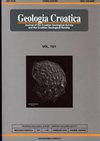Geological and structural setting of the Vinodol Valley (NW Adriatic, Croatia): insights into its tectonic evolution based on structural investigations
IF 1.1
4区 地球科学
Q3 GEOLOGY
引用次数: 13
Abstract
The area of the Vinodol Valley and Bakar Bay represents a NW‒SE oriented valley in the NW Adriatic characterised by prominent historical and instrumentally recorded seismicity. As part of the greater geodynamic domain including the Ilirska Bistrica–Rijeka–Senj seismogenic fault zone, new geological and structural data addressing the tectonic evolution of the area were collected in order to better understand the focal mechanisms of previous earthquakes and to enable identification of potential seismogenic sources. Mapped informal lithostratigraphic units mostly correspond to the Upper Cretaceous, Palaeogene and Quaternary successions described in other parts of the External Dinarides. However, a shorter stratigraphic range of the Gornji Humac fm., the youngest Cretaceous unit in the study area, was determined and suggests that the uplifted area in the central NW part of the Adriatic Carbonate Platform already comprised several thousand km2 (from W and NW Istria to Krk and Vinodol area) at the end of the Turonian. Structural measurements of the fault planes in the study area generally correspond to the existing structural model of the tectonic evolution of the Dinarides. However, in contrast to the SW vergences typical of the Dinarides, NE-vergent reverse structures are common, especially along the SW margin of the Vinodol Valley. Cross-cutting relationships suggest that transpressional (NW–SE and NE–SW striking dextral and sinistral faults) and extensional features (NW–SE and NE–SW striking normal faults) are structurally concurrent or younger than the reverse faults, suggesting a change in the palaeostress field during the Neogene–Quaternary, with prevalent transpression and radial extension. Comparison of results of the palaeostress field analysis and the constructed synthetic focal mechanisms on one side, with available focal mechanism solutions for earthquakes within the Ilirska Bistrica–Rijeka–Senj seismogenic fault zone on the other, shows a favourable orientation of the observed NW‒SE and NE‒SW striking faults with respect to the recent compressional/transpressional stress field (N‒S oriented P-axis), indicating these as potential seismogenic sources within the study area.克罗地亚亚得里亚海西北部Vinodol山谷的地质和构造环境:基于构造调查的构造演化见解
Vinodol山谷和Bakar湾地区代表了亚得里亚海西北部一个西北-东南方向的山谷,其特征是突出的历史和仪器记录的地震活动。作为包括Ilirska Bistrica–Rijeka–Senj发震断裂带在内的更大地球动力学领域的一部分,收集了有关该地区构造演化的新地质和结构数据,以更好地了解以前地震的震源机制,并能够识别潜在的发震源。映射的非正式岩石地层单位大多对应于外部二元系其他部分描述的上白垩纪、古近系和第四纪序列。然而,确定了研究区域中最年轻的白垩纪单元Gornji Humac.的较短地层范围,并表明亚得里亚海碳酸盐岩平台西北部中部的隆起区域在土仑纪末期已经包括数千平方公里(从伊斯特里亚西部和西北部到Krk和Vinodol地区)。研究区断层面的结构测量结果通常与现有的Dinarides构造演化结构模型相对应。然而,与二元系典型的西南向边缘相反,NE向边缘的反向结构很常见,尤其是在Vinodol山谷的西南边缘。横切关系表明,转挤压(NW–SE和NE–SW走向的右旋和左旋断层)和伸展特征(NW–东南和NE–西南走向的正断层)在结构上与逆断层平行或年轻,表明上第三纪-第四纪古应力场发生了变化,普遍存在转挤压和径向伸展。古应力场分析结果和构建的合成震源机制与Ilirska Bistrica–Rijeka–Senj发震断裂带内地震的可用震源机制解的比较,显示了观察到的NW-SE和NE-SW走向断层相对于最近的挤压/转挤压应力场(N-S方向的P轴)的有利方向,表明这些断层是研究区域内的潜在发震源。
本文章由计算机程序翻译,如有差异,请以英文原文为准。
求助全文
约1分钟内获得全文
求助全文
来源期刊

Geologia Croatica
GEOSCIENCES, MULTIDISCIPLINARY-
CiteScore
2.90
自引率
23.10%
发文量
35
审稿时长
>12 weeks
期刊介绍:
Geologia Croatica welcomes original scientific papers dealing with diverse aspects of geology and geological engineering, the history of the Earth, and the physical changes that the Earth has undergone or it is undergoing. The Journal covers a wide spectrum of geology disciplines (palaeontology, stratigraphy, mineralogy, sedimentology, petrology, geochemistry, structural geology, karstology, hydrogeology and engineering geology) including pedogenesis, petroleum geology and environmental geology.
Papers especially concerning the Pannonian Basin, Dinarides, the Adriatic/Mediterranean region, as well as notes and reviews interesting to a wider audience (e.g. review papers, book reviews, and notes) are welcome.
 求助内容:
求助内容: 应助结果提醒方式:
应助结果提醒方式:


